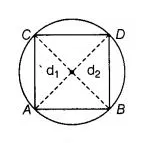All the vertices of a rhombus lie on a circle. Find the area of the rhombus, if area of the circle is $1256 \mathrm{~cm}^{2}$, (use $\pi=3.14$ )
Let the radius of the circle be r.

Given that. Area of the circle $=1256 \mathrm{~cm}^{2}$
$\pi r^{2}=1256$
$\Rightarrow$ $r^{2}=\frac{1256}{\pi}=\frac{1256}{3.14}=400$
$\Rightarrow$ $r^{2}=(20)^{2}$
$\Rightarrow$ $r=20 \mathrm{~cm}$
$\therefore$ So, the radius of circle is $20 \mathrm{~cm}$.
$\Rightarrow$ Diameter of circle $=2 \times$ Radius
$=2 \times 20$
$=40 \mathrm{~cm}$
Since, all the vertices of a rhombus lie on a circle that means each diagonal of a rhombus must pass through the centre of a circle that is why both
diagonals are equal and same as the diameter of the given circle.
Let $d_{1}$ and $d_{2}$ be the diagonals of the rhombus.
$\therefore \quad d_{1}=d_{2}=$ Diameter of circle $=40 \mathrm{~cm}$
So, $\quad$ Area of rhombus $=\frac{1}{2} \times d_{1} \times d_{2}$
$=\frac{1}{2} \times 40 \times 40$
$=20 \times 40=800 \mathrm{~cm}^{2}$
Hence, the required area of rhombus is 800 cm²
Click here to get exam-ready with eSaral
For making your preparation journey smoother of JEE, NEET and Class 8 to 10, grab our app now.
